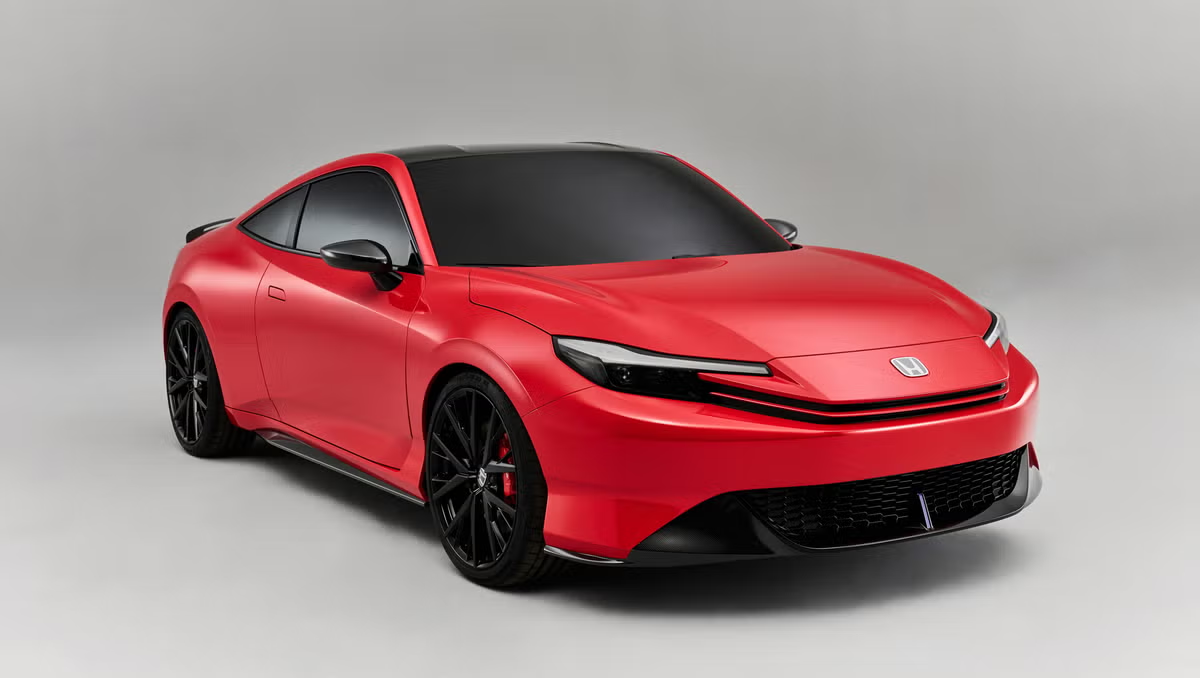AUTOMOTIVE
Toyota Raises Profit View by 9%, Shows Business Strength
Toyota raises profit forecast by 9%, reflecting strong business performance and growing demand for hybrid and electric vehicles. Find out what’s next!

Toyota Raises Profit: Toyota has once again demonstrated its dominance in the global automobile industry by raising its profit forecast by 9%. This strategic move underscores the company’s strong business performance, efficient cost management, and increased demand for its hybrid and electric vehicles.
Toyota’s consistent focus on innovation and sustainability has positioned it as a leader in the industry. This latest profit adjustment reflects not only its robust financial health but also its ability to navigate challenges in a dynamic market.
What Led to Toyota Raises Profit?
1. Strong Demand for Hybrid and Electric Vehicles
With the global shift towards eco-friendly vehicles, Toyota has capitalized on its strong lineup of hybrid and electric models. Its best-selling hybrids, such as the Toyota Prius and Toyota RAV4 Hybrid, continue to attract environmentally conscious consumers. The company’s commitment to sustainability has significantly boosted its sales worldwide.
Toyota’s latest battery-electric vehicle (BEV) strategy aims to make EVs more accessible, with models like the Toyota bZ4X leading the way. This investment in cleaner technology aligns with government regulations and consumer preferences.
2. Efficient Cost Management and Supply Chain Optimisation
Toyota has streamlined its manufacturing process, reducing production costs while maintaining high-quality standards. Additionally, the company has effectively tackled supply chain disruptions, ensuring a steady flow of semiconductors and essential automotive parts. This efficiency has played a crucial role in increasing profit margins.
Toyota’s use of Just-In-Time (JIT) manufacturing has enabled better inventory management, minimizing waste while keeping costs low. This well-established production method allows Toyota to adapt quickly to market changes.
3. Expansion into Emerging Markets
Toyota’s strategic expansion into emerging markets like India, Southeast Asia, and Latin America has contributed to higher sales volumes. By offering affordable and fuel-efficient vehicles, the company has strengthened its presence in price-sensitive regions.
Toyota’s local production facilities in these markets ensure cost efficiency and quicker delivery, making their vehicles more appealing to a growing middle-class population.
4. Currency Exchange Favourability
Fluctuations in currency exchange rates have also worked in Toyota’s favour. The depreciation of the Japanese yen has made Toyota’s exports more competitive, boosting revenue from international markets.
Toyota’s Vision for the Future
Investing in Sustainable Mobility
Toyota is committed to leading the future of sustainable mobility. The company has ramped up investments in hydrogen fuel cell technology and next-generation electric vehicles. Models like the Toyota Mirai and upcoming solid-state battery EVs are part of its ambitious plan to achieve carbon neutrality by 2050.
Toyota’s recent collaboration with Panasonic in battery development aims to improve battery efficiency, lifespan, and charging speed, making EVs more viable for the mass market.
Advancements in Autonomous Driving and AI
Toyota is also making significant strides in autonomous driving technology. With its Toyota Research Institute, the company is developing AI-powered self-driving systems that will revolutionize transportation.
Through its partnership with Uber and other tech firms, Toyota is working on ride-hailing and mobility services, paving the way for autonomous taxis in the near future.
How This Profit Growth Benefits Consumers
Toyota’s strong financial performance is not just good news for investors—it also benefits consumers in several ways:
1. More Innovative Vehicles at Competitive Prices
A financially strong Toyota can invest more in research and development, bringing advanced safety features, improved fuel efficiency, and smart technology into its vehicles without significantly increasing prices.
Toyota’s Toyota Safety Sense (TSS), an advanced driver assistance system, is becoming more widely available across various models, ensuring greater road safety.
2. Better After-Sales Service and Warranty Offers
With higher profits, Toyota can expand its customer service network and enhance warranty programs, ensuring a better ownership experience for buyers.
Toyota’s extended battery warranty on hybrid and electric vehicles offers consumers greater confidence in transitioning to cleaner technologies.
3. Expansion of Charging Infrastructure
For electric vehicle (EV) buyers, Toyota’s investments could mean better charging infrastructure, making EV ownership more convenient.
Toyota is also working with energy companies and governments to expand hydrogen refueling stations and fast-charging EV networks.
Step-by-Step Guide: How Toyota Maintains Its Market Leadership
Step 1: Investing in Cutting-Edge Technology
Toyota continuously invests in AI, robotics, and next-gen batteries to stay ahead of the competition.
Step 2: Expanding Sustainable Vehicle Lineup
By offering a diverse range of hybrid, plug-in hybrid, and electric models, Toyota meets the needs of various customer segments.
Step 3: Strengthening Global Partnerships
Toyota collaborates with tech companies, energy firms, and government agencies to drive industry-wide innovation.
Step 4: Enhancing Production Efficiency
Toyota implements lean manufacturing techniques, ensuring cost-effective production without compromising quality.
Step 5: Adapting to Market Trends
By analyzing consumer behavior and market dynamics, Toyota swiftly adjusts its strategies to maintain a competitive edge.
Step 6: Expanding Mobility as a Service (MaaS)
Toyota is actively investing in shared mobility solutions, such as car subscription services and autonomous ride-hailing, to cater to changing consumer preferences.
What Lies Ahead for Toyota?
With a 9% profit increase, Toyota is well-positioned to shape the future of automotive technology. As the industry moves towards electrification and autonomy, Toyota’s focus on sustainability, innovation, and customer satisfaction will continue to set it apart.
Toyota is also set to launch next-gen hydrogen-powered trucks, strengthening its commercial vehicle segment while reducing carbon footprints.
Consumers can look forward to more efficient, reliable, and eco-friendly vehicles while Toyota cements its status as a global automotive powerhouse.
Nissan Rejects Honda Merger Talks, Pursues Bold Independent Strategy
AUTOMOTIVE
All-Purpose Stainless Steel Shower Squeegee : The Ultimate Solution for Streak-Free Surfaces
Discover why the All-Purpose Stainless Steel Shower Squeegee outperforms competitors with its premium design, effortless water removal, and long-lasting construction for streak-free surfaces.

Introduction
The All-Purpose Stainless Steel Shower Squeegee with Adhesive Hook represents a significant upgrade in household cleaning tools designed for maintaining pristine bathroom and glass surfaces. This versatile cleaning implement offers a practical solution for eliminating water spots, soap residue, and streaks from various surfaces, including shower doors, bathroom mirrors, windows, and car windshields. The shower squeegee features a thoughtfully engineered design that combines durability, ergonomic handling, and effective water removal in one sleek package. Particularly beneficial for homeowners seeking to maintain spotless bathrooms, car enthusiasts desiring streak-free vehicle glass, and anyone committed to efficient cleaning routines, this tool addresses the common frustration of water marks without requiring harsh chemicals or excessive scrubbing. Its combination of professional-grade materials with user-friendly design makes it appropriate for both everyday household maintenance and more demanding commercial applications.

Product Specifications
The All-Purpose Stainless Steel Shower Squeegee comes with comprehensive specifications designed to deliver consistent performance across multiple surfaces:
Materials and Construction
- Made from premium 304 stainless steel with rust-resistant properties
- Silicone blade edge for streak-free cleaning without scratching surfaces
- Ergonomic TPR (thermoplastic rubber) handle with anti-slip grip
- Strong adhesive hook included for convenient storage
Dimensions and Weight
- Overall Length: 9.8 inches (25 cm)
- Blade Width: 8 inches (20.3 cm)
- Handle Length: 4.5 inches (11.4 cm)
- Weight: 5.6 ounces (159 grams)
- Thickness of silicone blade: 2 mm
Features and Functionality
- 95° optimized blade angle for maximum water removal efficiency
- Silicone blade edge designed for streak-free results on multiple surfaces
- Hanging hole in handle for alternative storage options
- Waterproof design suitable for constant bathroom exposure
- Temperature resistant from -40°F to 248°F (-40°C to 120°C)
- Detachable silicone blade for easy cleaning and replacement
- Adhesive hook with a weight capacity of up to 11 pounds (5 kg)
Compatibility
- Suitable for glass, mirrors, tile, marble, granite, and other non-porous surfaces
- Safe for use on tinted or treated glass surfaces
- Compatible with both flat and slightly curved surfaces
- Appropriate for indoor and outdoor applications
The standout specification is the combination of the premium stainless steel frame with the flexible silicone blade, offering both the durability needed for frequent use and the gentle touch required to protect delicate surfaces from scratches.

Customer Experience Analysis
The All-Purpose Stainless Steel Shower Squeegee has generated substantial feedback from users across various households and usage scenarios. Analyzing the aggregate customer experience reveals several consistent patterns that provide insight into real-world performance.
Positive Experience Patterns
Most satisfied users consistently highlight the squeegee’s effectiveness at actually removing water without leaving streaks. Many customers express surprise at how dramatically the tool reduces cleaning frequency by preventing water spots and soap scum buildup in the first place. The immediate visual improvement after using the squeegee has converted many skeptical purchasers into enthusiastic advocates. Numerous bathroom renovators mention incorporating this tool into their daily routines after seeing how it preserves the appearance of new shower doors and tile work.
The build quality receives frequent praise, with users appreciating the substantial weight and solid feel of the stainless steel construction. Many customers note that this squeegee feels notably more premium than plastic alternatives they’ve previously used. The comfortable grip gets specific mention from older users and those with arthritis, who find the ergonomic handle design allows them to clean effectively without hand strain.
Storage convenience appears as another satisfaction driver, with the included adhesive hook performing better than expected. Many users report the hook maintaining a strong hold even in constantly humid bathroom environments where other adhesive products have failed. The visual appeal of the stainless steel finish also receives appreciation, with customers noting it blends well with modern bathroom fixtures.

Critical Feedback Patterns
Some users experience difficulties with the adhesive hook, particularly when attached to textured surfaces or in extremely humid environments. A small percentage report needing to replace the hook with alternative mounting solutions within the first few months. Several customers mention the hook placement requires careful consideration, as reapplying it after removal often yields diminished adhesion.
The silicone blade generates mixed reactions, with some users reporting excellent performance while others note it requires proper technique to avoid leaving fine water lines. First-time squeegee users often experience a learning curve before achieving optimal results. Customers in areas with hard water sometimes report that while the squeegee removes most water, it can’t prevent mineral deposits without supplemental cleaning products.
Weight becomes a factor for some users, particularly when cleaning ceiling-height windows or shower panels. A few customers mention the solid construction they otherwise appreciate becomes unwieldy during extended vertical cleaning sessions. Some users with smaller hands note the handle diameter is larger than preferred, making extended use slightly uncomfortable.
Pros and Cons Section
Advantages
- Superior Water Removal: The precision-engineered silicone blade edge removes water more effectively than microfiber cloths or towels, leaving surfaces visibly cleaner with minimal effort.
- Exceptional Build Quality: The 304-grade stainless steel construction provides substantial durability, preventing the bending and warping common to plastic squeegees.
- Versatile Application: Performance remains consistent across multiple surfaces, including shower doors, windows, mirrors, and vehicle glass, eliminating the need for multiple cleaning tools.
- Ergonomic Design: The thoughtfully designed handle with TPR coating offers a comfortable grip even when wet, reducing hand fatigue during extended cleaning sessions.
- Convenient Storage Solution: The included high-quality adhesive hook provides reliable storage without drilling holes, preserving bathroom aesthetics.
- Long-Term Cost Efficiency: Regular use significantly reduces the need for specialized glass cleaners and chemical treatments, offering ongoing savings on cleaning supplies.
Limitations
- Learning Curve for Optimal Results: First-time users may need practice to master the correct angle and pressure required for streak-free results, creating initial frustration for some.
- Hook Placement Considerations: The adhesive hook requires careful installation on appropriate surfaces, with limited repositioning options once attached.
- Weight During Extended Use: The premium metal construction that contributes to durability may cause fatigue during lengthy cleaning sessions, particularly on vertical surfaces.
- Limited Effectiveness on Textured Surfaces: While excellent on smooth glass and tile, performance diminishes on heavily textured surfaces where the blade cannot maintain consistent contact.

Alternative Product Comparison
When comparing the All-Purpose Stainless Steel Shower Squeegee to the frequently viewed “Budget-Friendly Plastic Shower Squeegee with Suction Hook” alternative, several key differences emerge that impact overall value and performance.
Materials and Durability Comparison
The premium model utilizes 304 stainless steel construction with a silicone blade, while the budget alternative features ABS plastic with a rubber blade edge. In practice, this translates to significantly different lifespans, with the stainless steel version maintaining performance for years while the plastic version typically shows signs of wear, discoloration, or blade degradation within 6-12 months of regular use.
Performance Comparison
The weight and blade design of the stainless model provide more consistent pressure distribution, resulting in fewer streaks and more complete water removal compared to the lighter plastic version. However, the plastic model’s lighter weight makes it somewhat easier to manipulate for ceiling or high-reach applications.
Storage Solution Comparison
The premium model’s adhesive hook demonstrates superior longevity in humid environments, while the suction cup mount on the budget version requires more frequent reattachment but offers easier repositioning.
Price-Value Assessment
With the premium stainless steel model typically priced at 2-3 times the cost of the plastic alternative, the decision becomes a matter of immediate budget versus long-term value:
| Feature | Premium Stainless Steel Squeegee | Budget Plastic Squeegee |
|---|---|---|
| Material | 304 Stainless Steel | ABS Plastic |
| Blade | Silicone, replaceable | Rubber, fixed |
| Weight | 5.6 oz (159g) | 2.2 oz (62g) |
| Expected Lifespan | 3-5+ years | 6-12 months |
| Storage | Adhesive hook | Suction cup |
| Price Range | $15-20 | $5-8 |
Homeowners planning long-term use or seeking consistently superior performance would benefit from investing in the stainless steel model, while budget-conscious consumers or those with temporary needs might find adequate value in the plastic alternative. The premium model particularly excels for households with hard water issues, where the superior blade design makes a noticeable difference in preventing mineral buildup.
Usage/Installation Guide
To maximize the effectiveness of your All-Purpose Stainless Steel Shower Squeegee, follow these optimized usage guidelines:
Adhesive Hook Installation
- Select a smooth, clean, and dry surface for mounting
- Clean the chosen area thoroughly with alcohol and allow to dry completely (minimum 5 minutes)
- Remove the adhesive backing from the hook
- Press firmly against the mounting surface and hold for 30 seconds
- Allow 24 hours before hanging the squeegee for maximum adhesion strength
Proper Squeegee Technique
- Start at the upper corner of the glass or surface when the surface is still wet
- Hold the squeegee at approximately a 45° angle to the surface
- Apply gentle but consistent pressure across the blade
- Pull in straight, slightly overlapping strokes from top to bottom
- Wipe the blade clean with a towel between strokes for best results
- For final passes near edges, use slower strokes to prevent water droplets
Maintenance Tips
- Rinse the squeegee blade after each use to prevent soap buildup
- Periodically clean the silicone blade with warm, soapy water
- If the blade develops squeaking, apply a tiny amount of silicone lubricant
- Store hanging with the blade facing away from the wall to maintain optimal blade shape
- Replace the blade if it shows signs of wear or loses effectiveness (typically 12-18 months with daily use)
By following these specific techniques, users can overcome the common issues mentioned in critical reviews and achieve professional-quality, streak-free results consistently.
Click here to buy
Final Verdict & Recommendation
After a comprehensive analysis, the All-Purpose Stainless Steel Shower Squeegee proves itself to be an exceptional value proposition for anyone seeking to maintain pristine glass and hard surfaces with minimal effort. This product delivers on its primary promise: effectively removing water without leaving streaks, while offering durability that justifies its premium positioning.
The squeegee particularly excels in households with hard water conditions, where preventing mineral deposits becomes a daily challenge. Its performance consistently surpasses that of cloths, towels, and lower-quality squeegees, making it ideal for homeowners who have invested in glass shower enclosures, quality mirrors, or other surfaces vulnerable to water spotting. The design reflects thoughtful attention to real-world usage scenarios, with the ergonomic handle and effective blade geometry combining to reduce cleaning time and physical effort.
While the initial investment exceeds that of basic alternatives, the long-term value becomes evident through reduced cleaning product expenses, lower replacement frequency, and consistently superior results. The premium construction justifies the price point for daily users, though occasional users might find the value proposition less compelling.
This tool is most highly recommended for:
- Homeowners with glass shower enclosures or frameless shower doors
- Individuals seeking to reduce chemical cleaner usage in bathrooms
- Those with physical limitations that make traditional scrubbing difficult
- Anyone who values efficiency in their cleaning routine
- Households in hard water areas where water spotting is problematic
The All-Purpose Stainless Steel Shower Squeegee represents that rare household tool that delivers transformative results rather than marginal improvements, making it a worthwhile investment for anyone committed to maintaining spotless surfaces with minimal ongoing effort.
AUTOMOTIVE
Acer Nitro KG241Y Sbiip 23.8” Monitor Review: An Ultra-Smooth, High-Performance, Reliable Powerhouse for Budget Gamers
Experience seamless gaming with the Acer Nitro KG241Y Sbiip 23.8 – a budget-friendly monitor delivering high refresh rates and vibrant visuals.

The Acer Nitro KG241Y Sbiip is a 23.8-inch Full HD gaming monitor that combines affordability with performance. Designed for gamers and professionals alike, it offers a high refresh rate, quick response time, and AMD FreeSync Premium technology, ensuring smooth visuals and reduced screen tearing. Its sleek ZeroFrame design makes it a stylish addition to any setup.Revain

🛠️ Specifications
- Display Size: 23.8 inches
- Resolution: 1920 x 1080 (Full HD)
- Panel Type: VA
- Refresh Rate: 165Hz
- Response Time: 1ms (VRB)
- Brightness: 250 nits
- Contrast Ratio: 100,000,000:1 (ACM)
- Ports: 1 x DisplayPort 1.2, 2 x HDMI 2.0
- Adaptive Sync: AMD FreeSync Premium
- Design: ZeroFrame with tilt adjustment (-5° to 15°)
- VESA Mount Compatible: Yes (100 x 100mm)Amazon+3Revain+3Revain+3RevainRevain+3Revain+3Revain+3
🧑💻 User Reviews Summary
Users have praised the Acer Nitro KG241Y Sbiip for its impressive performance at an affordable price point.
Positive Feedback:
- Smooth Gaming Experience: Gamers appreciate the 165Hz refresh rate and 1ms response time, noting significant improvements in gameplay fluidity.
- Visual Clarity: The Full HD resolution and VA panel deliver sharp images and vibrant colors.
- Design: The ZeroFrame design offers an immersive viewing experience, and the monitor’s build quality is commendable.Revain
Constructive Criticism:
- Stand Adjustability: Some users mentioned the stand lacks height adjustment, recommending a VESA mount for better ergonomics.
- Color Calibration: A few users suggested that out-of-the-box color settings might require tweaking for optimal accuracy.Revain+2Revain+2Amazon+2
✅ Pros and ❌ Cons
Pros:
- ✅ High 165Hz refresh rate for smooth visuals
- ✅ Quick 1ms response time reduces motion blur
- ✅ AMD FreeSync Premium minimizes screen tearing
- ✅ Sleek ZeroFrame design enhances aesthetics
- ✅ Affordable price point for budget-conscious buyersRevainRevain
Cons:
- ❌ Stand lacks height and swivel adjustments
- ❌ Initial color settings may need calibration

🏁 Final Verdict
The Acer Nitro KG241Y Sbiip stands out as a top choice for gamers seeking high performance without breaking the bank. Its combination of a 165Hz refresh rate, 1ms response time, and AMD FreeSync Premium ensures a seamless gaming experience. While the stand’s adjustability is limited, this minor drawback is easily addressed with a VESA mount. Overall, this monitor offers exceptional value for its price.
🔄 Alternative Option
Acer R240HY bidx 23.8″ IPS HDMI DVI VGA Monitor
- Display Size: 23.8 inches
- Resolution: 1920 x 1080 (Full HD)
- Panel Type: IPS
- Refresh Rate: 60Hz
- Response Time: 4ms
- Ports: HDMI, DVI, VGA
- Design: ZeroFrame with tilt adjustment
- Price: Approximately $130Amazon+4Revain+4Revain+4Revain+2Revain+2Amazon+2
Comparison:
| Feature | Acer Nitro KG241Y Sbiip | Acer R240HY bidx |
|---|---|---|
| Refresh Rate | 165Hz | 60Hz |
| Response Time | 1ms | 4ms |
| Panel Type | VA | IPS |
| Adaptive Sync | AMD FreeSync Premium | None |
| Price | ~$150 | ~$130 |
While the Acer R240HY offers an IPS panel for better color accuracy, the Nitro KG241Y Sbiip provides superior performance for gaming with its higher refresh rate and quicker response time.
🛠️ Setup Guide
- Unboxing: Carefully remove the monitor and accessories from the packaging.
- Stand Assembly: Attach the stand to the monitor using the provided screws.
- Placement: Place the monitor on a flat surface, ensuring stability.
- Connectivity: Connect the monitor to your PC or console using the DisplayPort or HDMI cable.
- Power Up: Plug in the power adapter and turn on the monitor.
- Settings Adjustment: Use the on-screen display (OSD) menu to adjust brightness, contrast, and other settings to your preference.
- Driver Installation: Ensure your graphics drivers are up to date for optimal performance.

AUTOMOTIVE
Rowenta Pure Force 2-in-1 Steamer & Iron (DR8822) Review: The Ultimate Powerhouse for Effortless, Wrinkle-Free Living.
Experience the convenience of wrinkle-free clothing with the Rowenta Pure Force 2-in-1 Steamer & Iron—your ultimate garment care solution.

Looking for a versatile garment care solution? The Rowenta Pure Force 2-in-1 Steamer & Iron (DR8822) combines the convenience of a handheld steamer with the precision of an iron, offering a powerful tool for maintaining crisp, wrinkle-free clothing and fabrics.

Specifications
- Model: DR8822
- Power: 1875 Watts
- Water Tank Capacity: 7.1 oz (210 ml)
- Steam Settings: Multiple levels including a boost mode
- Heating Time: Approximately 45 seconds
- Weight: 2.95 lbs (1.34 kg)
- Cord Length: 8.5 feet (2.6 meters)
- Functionality: Vertical steaming and horizontal ironing
- Safety: Auto shut-off feature
- Design: Ergonomic handle with a sleek green finish
User Reviews Summary
With a 4.2 out of 5 stars rating from over 650 global reviews, users have highlighted the following:
Most Praised Features
- Quick Heat-Up: Users appreciate the rapid heating time, allowing for efficient use.
- Powerful Steam Output: Effective in removing wrinkles from various fabrics.
- Dual Functionality: The ability to steam and iron adds versatility.
- Build Quality: Sturdy construction that feels durable and reliable.
- Ease of Use: Simple setup and operation, suitable for daily use.
Most Criticized Features
- Water Leakage: Some users report minor leaks, especially at higher settings.
- Weight: A few users find it slightly heavy for extended use.
- Water Tank Capacity: Requires frequent refills during prolonged steaming sessions.
Pros and Cons
Pros
- Versatile Usage: Functions as both a steamer and an iron.
- Fast Performance: Heats up quickly and delivers strong steam.
- User-Friendly: Easy to operate with intuitive controls.
- Safety Features: Auto shut-off adds a layer of safety.
- Long Cord: Provides flexibility during use.
Cons
- Potential for Leaks: Some reports of water leakage at high settings.
- Heavier Than Some Models: May cause fatigue during extended use.
- Small Water Tank: May require frequent refilling for large tasks.

Final Recommendation
The Rowenta Pure Force 2-in-1 Steamer & Iron (DR8822) is a robust and versatile tool ideal for those seeking a quick and efficient way to maintain wrinkle-free clothing. Its dual functionality and powerful steam output make it a valuable addition to any household. However, potential buyers should be aware of its weight and the possibility of minor water leakage.
Alternative Lower-Priced Product
Conair Turbo ExtremeSteam Handheld Fabric Steamer
- Power: 1550 Watts
- Water Tank Capacity: 7.3 oz
- Heating Time: 40 seconds
- Weight: 2.2 lbs
- Price: Approximately $50
Comparison Table
| Feature | Rowenta DR8822 | Conair Turbo ExtremeSteam |
|---|---|---|
| Power | 1875 Watts | 1550 Watts |
| Water Tank Capacity | 7.1 oz | 7.3 oz |
| Heating Time | ~45 seconds | ~40 seconds |
| Weight | 2.95 lbs | 2.2 lbs |
| Dual Functionality | Yes (Steamer & Iron) | Steamer Only |
| Price | Higher | Lower |
The Conair Turbo ExtremeSteam offers a lightweight and affordable alternative, suitable for those primarily interested in steaming.
Usage Guide
- Fill the Water Tank: Use clean water to fill the 7.1 oz tank.
- Power On: Plug in the device and select the desired steam setting.
- Wait for Heat-Up: Allow approximately 45 seconds for the device to heat up.
- Steam or Iron: Use vertically for steaming garments on hangers or horizontally for ironing on a flat surface.
- Refill as Needed: Monitor the water level and refill when necessary.
- Turn Off and Unplug: After use, turn off the device and unplug it. Allow it to cool before storing.

-

 GADGETS3 months ago
GADGETS3 months agobest travel steamer 2025: Neakasa Magic 1 Vacuum Steamer Review – Worth It?
-

 AUTOMOTIVE3 months ago
AUTOMOTIVE3 months agoAmazon Basics USB Condenser Microphone Review: Affordable Quality for Streamers & Podcasters
-

 TECHNOLOGY2 months ago
TECHNOLOGY2 months agoSteam Data Breach: Revealed How to Safeguard Your Accout
-

 GADGETS4 months ago
GADGETS4 months agoBest Affordable VR Headsets in 2025: Top Picks for Budget-Friendly Immersion
-

 GADGETS6 months ago
GADGETS6 months agoHow to Connect Magic Mouse to Windows 11
-

 NEWS1 month ago
NEWS1 month agoMark Zuckerberg Overtakes Jeff Bezos: A Powerful Billionaire Shift
-

 ARTIFICIAL INTELLIGENCE3 months ago
ARTIFICIAL INTELLIGENCE3 months ago50 Mind-Blowing ChatGPT Prompts You Wish You Knew Sooner (2025 Edition)
-

 COMPUTING2 months ago
COMPUTING2 months agoLenovo V15 Business Laptop Review: Affordable Efficiency Meets Everyday Power




